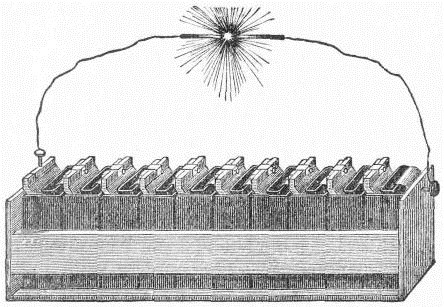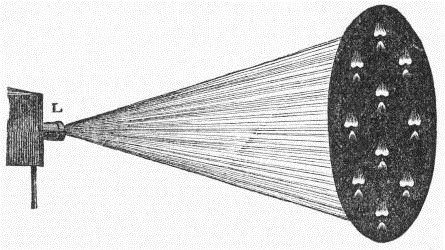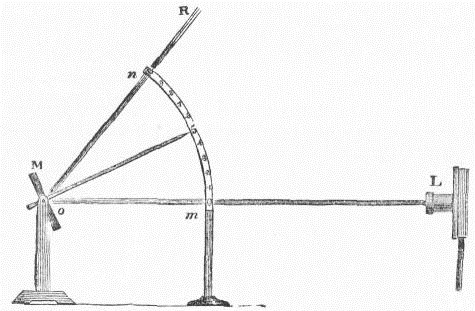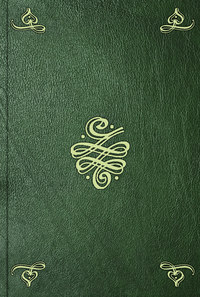 полная версия
полная версияSix Lectures on Light. Delivered In The United States In 1872-1873

John Tyndall
Six Lectures on Light / Delivered In The United States In 1872-1873
PREFACE TO THE FOURTH EDITION
In these Lectures I have sought to render clear a difficult but profoundly interesting subject. My aim has been not only to describe and illustrate in a familiar manner the principal laws and phenomena of light, but to point out the origin, and show the application, of the theoretic conceptions which underlie and unite the whole, and without which no real interpretation is possible.
The Lectures, as stated on the title-page, were delivered in the United States in 1872-3. I still retain a vivid and grateful remembrance of the cordiality with which they were received.
My scope and object are briefly indicated in the 'Summary and Conclusion,' which, as recommended in a former edition, might be, not unfitly, read as an introduction to the volume.
J.T.
ALP LUSGEN: October 1885.ON LIGHT
LECTURE I
INTRODUCTORY
USES OF EXPERIMENT
EARLY SCIENTIFIC NOTIONS
SCIENCES OF OBSERVATION
KNOWLEDGE OF THE ANCIENTS REGARDING LIGHT
DEFECTS OF THE EYE
OUR INSTRUMENTS
RECTILINEAL PROPAGATION OF LIGHT
LAW OF INCIDENCE AND REFLECTION
STERILITY OF THE MIDDLE AGES
REFRACTION
DISCOVERY OF SNELL
PARTIAL AND TOTAL REFLECTION
VELOCITY OF LIGHT
ROEMER, BRADLEY, FOUCAULT, AND FIZEAU
PRINCIPLE OF LEAST ACTION
DESCARTES AND THE RAINBOW
NEWTON'S EXPERIMENTS ON THE COMPOSITION OF SOLAR LIGHT
HIS MISTAKE AS REGARDS ACHROMATISM
SYNTHESIS OF WHITE LIGHT
YELLOW AND BLUE LIGHTS PRODUCE WHITE BY THEIR MIXTURE
COLOURS OF NATURAL BODIES
ABSORPTION
MIXTURE OF PIGMENTS CONTRASTED WITH MIXTURE OF LIGHTS.
§ 1. Introduction
Some twelve years ago I published, in England, a little book entitled the 'Glaciers of the Alps,' and, a couple of years subsequently, a second book, entitled 'Heat a Mode of Motion.' These volumes were followed by others, written with equal plainness, and with a similar aim, that aim being to develop and deepen sympathy between science and the world outside of science. I agreed with thoughtful men1 who deemed it good for neither world to be isolated from the other, or unsympathetic towards the other, and, to lessen this isolation, at least in one department of science, I swerved, for a time, from those original researches which have been the real pursuit and pleasure of my life.
The works here referred to were, for the most part, republished by the Messrs. Appleton of New York,2 under the auspices of a man who is untiring in his efforts to diffuse sound scientific knowledge among the people of the United States; whose energy, ability, and single-mindedness, in the prosecution of an arduous task, have won for him the sympathy and support of many of us in 'the old country.' I allude to Professor Youmans. Quite as rapidly as in England, the aim of these works was understood and appreciated in the United States, and they brought me from this side of the Atlantic innumerable evidences of good-will. Year after year invitations reached me3 to visit America, and last year (1871) I was honoured with a request so cordial, signed by five-and-twenty names, so distinguished in science, in literature, and in administrative position, that I at once resolved to respond to it by braving not only the disquieting oscillations of the Atlantic, but the far more disquieting ordeal of appearing in person before the people of the United States.
This invitation, conveyed to me by my accomplished friend Professor Lesley, of Philadelphia, and preceded by a letter of the same purport from your scientific Nestor, the celebrated Joseph Henry, of Washington, desired that I should lecture in some of the principal cities of the Union. This I agreed to do, though much in the dark as to a suitable subject. In answer to my inquiries, however, I was given to understand that a course of lectures, showing the uses of experiment in the cultivation of Natural Knowledge, would materially promote scientific education in this country. And though such lectures involved the selection of weighty and delicate instruments, and their transfer from place to place, I determined to meet the wishes of my friends, as far as the time and means at my disposal would allow.
§ 2. Subject of the Course. Source of Light employed
Experiments have two great uses—a use in discovery, and a use in tuition. They were long ago defined as the investigator's language addressed to Nature, to which she sends intelligible replies. These replies, however, usually reach the questioner in whispers too feeble for the public ear. But after the investigator comes the teacher, whose function it is so to exalt and modify the experiments of his predecessor, as to render them fit for public presentation. This secondary function I shall endeavour, in the present instance, to fulfil.
Taking a single department of natural philosophy as my subject, I propose, by means of it, to illustrate the growth of scientific knowledge under the guidance of experiment. I wish, in the first place, to make you acquainted with certain elementary phenomena; then to point out to you how the theoretical principles by which phenomena are explained take root in the human mind, and finally to apply these principles to the whole body of knowledge covered by the lectures. The science of optics lends itself particularly well to this mode of treatment, and on it, therefore, I propose to draw for the materials of the present course. It will be best to begin with the few simple facts regarding light which were known to the ancients, and to pass from them, in historic gradation, to the more abstruse discoveries of modern times.
All our notions of Nature, however exalted or however grotesque, have their foundation in experience. The notion of personal volition in Nature had this basis. In the fury and the serenity of natural phenomena the savage saw the transcript of his own varying moods, and he accordingly ascribed these phenomena to beings of like passions with himself, but vastly transcending him in power. Thus the notion of causality—the assumption that natural things did not come of themselves, but had unseen antecedents—lay at the root of even the savage's interpretation of Nature. Out of this bias of the human mind to seek for the causes of phenomena all science has sprung.
We will not now go back to man's first intellectual gropings; much less shall we enter upon the thorny discussion as to how the groping man arose. We will take him at that stage of his development, when he became possessed of the apparatus of thought and the power of using it. For a time—and that historically a long one—he was limited to mere observation, accepting what Nature offered, and confining intellectual action to it alone. The apparent motions of sun and stars first drew towards them the questionings of the intellect, and accordingly astronomy was the first science developed. Slowly, and with difficulty, the notion of natural forces took root in the human mind. Slowly, and with difficulty, the science of mechanics had to grow out of this notion; and slowly at last came the full application of mechanical principles to the motions of the heavenly bodies. We trace the progress of astronomy through Hipparchus and Ptolemy; and, after a long halt, through Copernicus, Galileo, Tycho Brahe, and Kepler; while from the high table-land of thought occupied by these men, Newton shoots upwards like a peak, overlooking all others from his dominant elevation.
But other objects than the motions of the stars attracted the attention of the ancient world. Light was a familiar phenomenon, and from the earliest times we find men's minds busy with the attempt to render some account of it. But without experiment, which belongs to a later stage of scientific development, little progress could be here made. The ancients, accordingly, were far less successful in dealing with light than in dealing with solar and stellar motions. Still they did make some progress. They satisfied themselves that light moved in straight lines; they knew also that light was reflected from polished surfaces, and that the angle of incidence was equal to the angle of reflection. These two results of ancient scientific curiosity constitute the starting-point of our present course of lectures.
But in the first place it will be useful to say a few words regarding the source of light to be employed in our experiments. The rusting of iron is, to all intents and purposes, the slow burning of iron. It develops heat, and, if the heat be preserved, a high temperature may be thus attained. The destruction of the first Atlantic cable was probably due to heat developed in this way. Other metals are still more combustible than iron. You may ignite strips of zinc in a candle flame, and cause them to burn almost like strips of paper. But we must now expand our definition of combustion, and include under this term, not only combustion in air, but also combustion in liquids. Water, for example, contains a store of oxygen, which may unite with, and consume, a metal immersed in it; it is from this kind of combustion that we are to derive the heat and light employed in our present course.
The generation of this light and of this heat merits a moment's attention. Before you is an instrument—a small voltaic battery—in which zinc is immersed in a suitable liquid. An attractive force is at this moment exerted between the metal and the oxygen of the liquid; actual combination, however, being in the first instance avoided. Uniting the two ends of the battery by a thick wire, the attraction is satisfied, the oxygen unites with the metal, zinc is consumed, and heat, as usual, is the result of the combustion. A power which, for want of a better name, we call an electric current, passes at the same time through the wire.
Cutting the thick wire in two, let the severed ends be united by a thin one. It glows with a white heat. Whence comes that heat? The question is well worthy of an answer. Suppose in the first instance, when the thick wire is employed, that we permit the action to continue until 100 grains of zinc are consumed, the amount of heat generated in the battery would be capable of accurate numerical expression. Let the action then continue, with the thin wire glowing, until 100 grains of zinc are consumed. Will the amount of heat generated in the battery be the same as before? No; it will be less by the precise amount generated in the thin wire outside the battery. In fact, by adding the internal heat to the external, we obtain for the combustion of 100 grains of zinc a total which never varies. We have here a beautiful example of that law of constancy as regards natural energies, the establishment of which is the greatest achievement of modern science. By this arrangement, then, we are able to burn our zinc at one place, and to exhibit the effects of its combustion at another. In New York, for example, we may have our grate and fuel; but the heat and light of our fire may be made to appear at San Francisco.

Fig. 1.
Removing the thin wire and attaching to the severed ends of the thick one two rods of coke we obtain, on bringing the rods together (as in fig. 1), a small star of light. Now, the light to be employed in our lectures is a simple exaggeration of this star. Instead of being produced by ten cells, it is produced by fifty. Placed in a suitable camera, provided with a suitable lens, this powerful source will give us all the light necessary for our experiments.
And here, in passing, I am reminded of the common delusion that the works of Nature, the human eye included, are theoretically perfect. The eye has grown for ages towards perfection; but ages of perfecting may be still before it. Looking at the dazzling light from our large battery, I see a luminous globe, but entirely fail to see the shape of the coke-points whence the light issues. The cause may be thus made clear: On the screen before you is projected an image of the carbon points, the whole of the glass lens in front of the camera being employed to form the image. It is not sharp, but surrounded by a halo which nearly obliterates the carbons. This arises from an imperfection of the glass lens, called its spherical aberration, which is due to the fact that the circumferential and central rays have not the same focus. The human eye labours under a similar defect, and from this, and other causes, it arises that when the naked light from fifty cells is looked at the blur of light upon the retina is sufficient to destroy the definition of the retinal image of the carbons. A long list of indictments might indeed be brought against the eye—its opacity, its want of symmetry, its lack of achromatism, its partial blindness. All these taken together caused Helmholt to say that, if any optician sent him an instrument so defective, he would be justified in sending it back with the severest censure. But the eye is not to be judged from the standpoint of theory. It is not perfect, but is on its way to perfection. As a practical instrument, and taking the adjustments by which its defects are neutralized into account, it must ever remain a marvel to the reflecting mind.
§ 3. Rectilineal Propagation of Light. Elementary Experiments. Law of Reflection
The ancients were aware of the rectilineal propagation of light. They knew that an opaque body, placed between the eye and a point of light, intercepted the light of the point. Possibly the terms 'ray' and 'beam' may have been suggested by those straight spokes of light which, in certain states of the atmosphere, dart from the sun at his rising and his setting. The rectilineal propagation of light may be illustrated by permitting the solar light to enter, through a small aperture in a window-shutter, a dark room in which a little smoke has been diffused. In pure air you cannot see the beam, but in smoky air you can, because the light, which passes unseen through the air, is scattered and revealed by the smoke particles, among which the beam pursues a straight course.

Fig. 2.
The following instructive experiment depends on the rectilineal propagation of light. Make a small hole in a closed window-shutter, before which stands a house or a tree, and place within the darkened room a white screen at some distance from the orifice. Every straight ray proceeding from the house, or tree, stamps its colour upon the screen, and the sum of all the rays will, therefore, be an image of the object. But, as the rays cross each other at the orifice, the image is inverted. At present we may illustrate and expand the subject thus: In front of our camera is a large opening (L, fig. 2), from which the lens has been removed, and which is closed at present by a sheet of tin-foil. Pricking by means of a common sewing-needle a small aperture in the tin-foil, an inverted image of the carbon-points starts forth upon the screen. A dozen apertures will give a dozen images, a hundred a hundred, a thousand a thousand. But, as the apertures come closer to each other, that is to say, as the tin-foil between the apertures vanishes, the images overlap more and more. Removing the tin-foil altogether, the screen becomes uniformly illuminated. Hence the light upon the screen may be regarded as the overlapping of innumerable images of the carbon-points. In like manner the light upon every white wall, on a cloudless day, may be regarded as produced by the superposition of innumerable images of the sun.

Fig. 3.
The law that the angle of incidence is equal to the angle of reflection has a bearing upon theory, to be subsequently mentioned, which renders its simple illustration here desirable. A straight lath (pointing to the figure 5 on the arc in fig. 3) is fixed as an index perpendicular to a small looking-glass (M), capable of rotation. We begin by receiving a beam of light upon the glass which is reflected back along the line of its incidence. The index being then turned, the mirror turns with it, and at each side of the index the incident and the reflected beams (L o, o R) track themselves through the dust of the room. The mere inspection of the two angles enclosed between the index and the two beams suffices to show their equality; while if the graduated arc be consulted, the arc from 5 to m is found accurately equal to the arc from 5 to n. The complete expression of the law of reflection is, not only that the angles of incidence and reflection are equal, but that the incident and reflected rays always lie in a plane perpendicular to the reflecting surface.
This simple apparatus enables us to illustrate another law of great practical importance, namely, that when a mirror rotates, the angular velocity of a beam reflected from it is twice that of the reflecting mirror. A simple experiment will make this plain. The arc (m n, fig. 3) before you is divided into ten equal parts, and when the incident beam and the index cross the zero of the graduation, both the incident and reflected beams are horizontal. Moving the index of the mirror to 1, the reflected beam cuts the arc at 2; moving the index to 2, the arc is cut at 4; moving the index to 3, the arc is cut at 6; moving the index at 4, the arc is cut at 8; finally, moving the index to 5, the arc is cut at 10 (as in the figure). In every case the reflected beam moves through twice the angle passed over by the mirror.
One of the principal problems of science is to help the senses of man, by carrying them into regions which could never be attained without that help. Thus we arm the eye with the telescope when we want to sound the depths of space, and with the microscope when we want to explore motion and structure in their infinitesimal dimensions. Now, this law of angular reflection, coupled with the fact that a beam of light possesses no weight, gives us the means of magnifying small motions to an extraordinary degree. Thus, by attaching mirrors to his suspended magnets, and by watching the images of divided scales reflected from the mirrors, the celebrated Gauss was able to detect the slightest thrill of variation on the part of the earth's magnetic force. By a similar arrangement the feeble attractions and repulsions of the diamagnetic force have been made manifest. The minute elongation of a bar of metal, by the mere warmth of the hand, may be so magnified by this method, as to cause the index-beam to move through 20 or 30 feet. The lengthening of a bar of iron when it is magnetized may be also thus demonstrated. Helmholtz long ago employed this method of rendering evident to his students the classical experiments of Du Bois Raymond on animal electricity; while in Sir William Thomson's reflecting galvanometer the principle receives one of its latest and most important applications.
§ 4. The Refraction of Light. Total Reflection
For more than a thousand years no step was taken in optics beyond this law of reflection. The men of the Middle Ages, in fact, endeavoured, on the one hand, to develop the laws of the universe à priori out of their own consciousness, while many of them were so occupied with the concerns of a future world that they looked with a lofty scorn on all things pertaining to this one. Speaking of the natural philosophers of his time, Eusebius says, 'It is not through ignorance of the things admired by them, but through contempt of their useless labour, that we think little of these matters, turning our souls to the exercise of better things.' So also Lactantius—'To search for the causes of things; to inquire whether the sun be as large as he seems; whether the moon is convex or concave; whether the stars are fixed in the sky, or float freely in the air; of what size and of what material are the heavens; whether they be at rest or in motion; what is the magnitude of the earth; on what foundations is it suspended or balanced;—to dispute and conjecture upon such matters is just as if we chose to discuss what we think of a city in a remote country, of which we never heard but the name.'
As regards the refraction of light, the course of real inquiry was resumed in 1100 by an Arabian philosopher named Alhazen. Then it was taken up in succession by Roger Bacon, Vitellio, and Kepler. One of the most important occupations of science is the determination, by precise measurements, of the quantitative relations of phenomena; the value of such measurements depending greatly upon the skill and conscientiousness of the man who makes them. Vitellio appears to have been both skilful and conscientious, while Kepler's habit was to rummage through the observations of his predecessors, to look at them in all lights, and thus distil from them the principles which united them. He had done this with the astronomical measurements of Tycho Brahe, and had extracted from them the celebrated 'laws of Kepler.' He did it also with Vitellio's measurements of refraction. But in this case he was not successful. The principle, though a simple one, escaped him, and it was first discovered by Willebrord Snell, about the year 1621.
Less with the view of dwelling upon the phenomenon itself than of introducing it in a form which will render subsequently intelligible to you the play of theoretic thought in Newton's mind, the fact of refraction may be here demonstrated. I will not do this by drawing the course of the beam with chalk on a black board, but by causing it to mark its own white track before you. A shallow circular vessel (RIG, fig. 4), half filled with water, rendered slightly turbid by the admixture of a little milk, or the precipitation of a little mastic, is placed with its glass front vertical. By means of a small plane reflector (M), and through a slit (I) in the hoop surrounding the vessel, a beam of light is admitted in any required direction. It impinges upon the water (at O), enters it, and tracks itself through the liquid in a sharp bright band (O G). Meanwhile the beam passes unseen through the air above the water, for the air is not competent to scatter the light. A puff of smoke into this space at once reveals the track of the incident-beam. If the incidence be vertical, the beam is unrefracted. If oblique, its refraction at the common surface of air and water (at O) is rendered clearly visible. It is also seen that reflection (along O R) accompanies refraction, the beam dividing itself at the point of incidence into a refracted and a reflected portion.4

Fig. 4.
The law by which Snell connected together all the measurements executed up to his time, is this: Let A B C D (fig. 5) represent the outline of our circular vessel, A C being the water-line. When the beam is incident along B E, which is perpendicular to A C, there is no refraction. When it is incident along m E, there is refraction: it is bent at E and strikes the circle at n. When it is incident along m' E there is also refraction at E, the beam striking the point n'. From the ends of the two incident beams, let the perpendiculars m o, m' o' be drawn upon B D, and from the ends of the refracted beams let the perpendiculars p n, p' n' be also drawn. Measure the lengths of o m and of p n, and divide the one by the other. You obtain a certain quotient. In like manner divide m' o' by the corresponding perpendicular p' n'; you obtain precisely the same quotient. Snell, in fact, found this quotient to be a constant quantity for each particular substance, though it varied in amount from one substance to another. He called the quotient the index of refraction.



